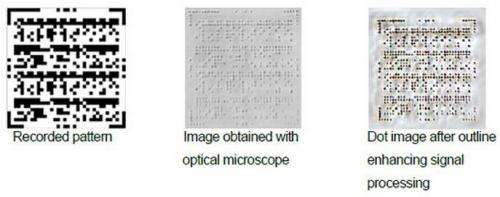Storage technology developed for fused silica glass to record and read digital data in the order of CD recording density

Hitachi today announced the development of technology for the semi-perpetual storage of digital data in fused silica glass which is known for its high resistance to heat and water, in collaboration with the laboratory of Professor MIURA Kiyotaka of the School of Engineering, Kyoto University. The data is recorded using a laser, and can be read using an optical microscope. High recording density was achieved by creating multiple recording layers within the fused silica by changing the focal point of the laser. In the current research, a recording density comparable to that of a compact disc (henceforth, CD) was successfully achieved with 4 layers.
Further, it was confirmed that data could be read without degradation even after subjecting the fused silica to an accelerated temperature test of 1,000℃ for 2 hours, indicating that long-term data storage in the order of several hundred million years is possible. This technology is expected to provide a new means for semi-perpetual data storage of valuable data such as historically important legacies and public documents, and personal data that individuals may wish to preserve for future generations.
With the progress of an IT society and the rapid transition of records from paper to digital media, there is a need to establish long-term storage technology. In particular with respect to cultural heritages or public documents, semi-perpetual storage technology permitting access to recorded data throughout generations without any degradation resulting from heat or humidity, is necessary.
In 2009, Hitachi proposed using fused silica known for its excellent heat and water resistance as a recording medium for long-term digital data storage, and confirmed the feasibility of a method to read digital data with computed tomography using LED light.(1) In order to make the technology practical however, high-speed and high-density data recording and simple read technology needed to be developed. To resolve these issues, Hitachi has developed multi-layer recording technology and simultaneous multi-bit recording technology to enable high-speed high-density recording. Furthermore, read technology using a conventional commercially available optical microscope was developed, achieving simple access to the recorded data. Details of the technology developed are as described below.
High-speed high-density recording technology using a femtosecond laser
When a femtosecond laser is irradiated into fused silica, minute structurally altered regions (dots) which have a different refractive index are formed. Digital data can therefore be recorded by generating a dot for the binary bit "1" and "no dot" for "0". In order to increase storage capacity, multi-layer recording technology was developed by optimizing laser power, and the spacing and depth between the dots, enabling high density recording. Further, to increase recording speed, a spatial light modulator (SLM) capable of two-dimensionally modulating the amplitude and phase of light was used to develop simultaneous multi-bit recording technology capable of recording a batch of one hundred dots.
Read technology using an optical microscope
Technology was developed to enable simple access to the digital data using a conventional optical microscope. Normally, if an optical microscope is used to observe multi-layer recorded fused silica, the image of the dots in the other layers appear as noise, reducing the image quality of the layer being read. To enable the data recorded in each of the four layers to be accurately read, technology was developed to enhance contrast by using two data block images taken at different focal points. Further, by emphasizing the outline of the dots through signal processing, a signal to noise ratio (S/N ratio) of 15 dB, equivalent to zero read error, was achieved for all four layers.
Using the technology developed for four layer recording, a recording density of 40 MB/inch2 technology which exceeds that of a CD at 35MB/inch2 was achieved. Further, it was confirmed that in reading the data, no degradation occurred even after conducting an accelerated temperature resistance test of 1,000℃ for 2 hours. By further increasing recording density, Hitachi will proceed towards practical application through verification tests.
These results will be presented at the International Symposium on Optical Memory (ISOM2012) which will be held from September 30 to October 4, 2012 at the National Museum of Emerging Science and Innovation (Miraikan) in Tokyo, Japan.
Provided by Hitachi

















